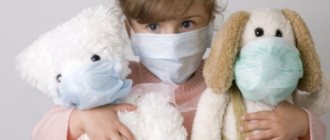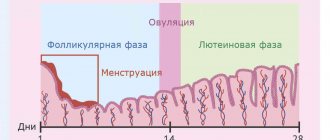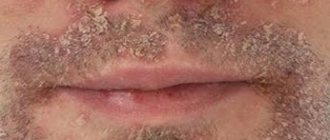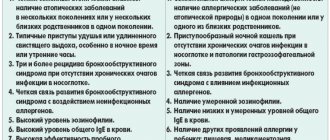Cough is the most common problem that every child faces sooner or later, and the second most frequently reported symptom after a runny nose. The reality is that most Kaliningrad residents treat children themselves at home, not realizing that this symptom can be a sign of a number of serious diseases. In this regard, parents need to understand how important it is to correctly assess the baby’s condition, promptly respond to dangerous symptoms and show the child to a doctor. Our specialists remind parents of the most important points regarding dry cough that they need to take note of.
Causes of the cough reflex
It's no secret that in most cases the cause of cough is viral and bacterial infections. However, it makes sense to list all the possible causes of irritation of the larynx, these are:
- viruses and bacteria;
- allergies to tree or grass pollen, etc.;
- dysfunction of the organs of the gastroesophageal zone;
- foreign object caught in the respiratory tract;
- psychogenic causes (anxiety).
As we mentioned earlier, an irritating dry cough can be a symptom of many respiratory diseases, including:
- ARVI;
- bronchitis;
- bronchial asthma.
These are the most common diseases, accompanied by coughing attacks, arranged in descending order. Others are much less common, but this does not make them any less dangerous - whooping cough, tracheitis, pneumonia, etc. Consultation with an otolaryngologist is necessary to exclude pathologies of the upper and lower respiratory tract.
Symptoms of dry cough in children with various respiratory diseases
A dry cough in children indicates that the airways are not cleared of mucus, which means it stagnates, which can lead to bronchitis or pneumonia. It is easy to recognize: a sore throat, the inability to cough, attacks of dry cough in a child that are repeated over and over again. This cough gets worse in a warm room and immediately after the baby goes to bed.
acute respiratory infections and acute respiratory viral infections
With acute respiratory infections, acute respiratory viral infections, a dry, non-productive cough causes a lot of suffering to the child. The temperature may rise to high levels, and then parents have to call emergency help to normalize the baby’s condition. A dry cough irritates the pharyngeal mucosa and increases blood pressure.
Respiratory viral diseases in childhood are accompanied not only by cough, but also by other characteristic signs:
- body aches;
- headaches;
- stool disorder;
- runny nose;
- hoarseness of voice;
- enlarged pharyngeal tonsils;
- nasal congestion;
- increased temperature;
- enlarged adenoids;
- chills, signs of fever;
- loss of appetite;
- redness of the throat, the appearance of a white coating on the tongue.
The younger the child, the more difficult it is for him to tolerate viral infections such as acute respiratory viral infections and acute respiratory infections, which, without treatment, can be complicated by diseases of the upper respiratory tract, which, as a rule, occur chronically, with frequent exacerbations and persistent cough. It can be quite difficult to cure. Every parent strives to help their child by purchasing remedies for dry cough in children, but it is better not to joke with medications. Only a doctor should prescribe them.
Bronchitis and tracheitis
Tracheitis and bronchitis are common complications of acute respiratory infections, influenza, ARVI and other viral infections. Sometimes diseases run their course on their own, but this is rare. With tracheitis, infectious pathogens cause inflammation of the trachea - the tube connecting the bronchi and larynx. The cough with this disease is dry, painful, and worsens at night and in the morning. The temperature remains within normal limits, and chest pain may occur. With bronchitis, the cough is usually dry in the first days of the illness, and then it becomes moist, and sputum begins to actively drain. Additionally, the child experiences a runny nose, sore throat, headaches, weakness, and increased fatigue.
Laryngitis and pharyngitis
With laryngitis (inflammation of the laryngeal mucosa), the child’s cough is dry, paroxysmal and painful, sputum is difficult to separate due to its increased viscosity. In this case, a sore throat may develop, and a headache often appears. With an exacerbation of laryngitis, the body temperature often rises, the tonsils may be swollen and red, as well as the vocal cords. Pharyngitis (inflammation of the pharynx) occurs with a dry cough, redness of the back of the throat, increased temperature and a sore throat. In most cases, sputum is not produced, unless the disease occurs against the background of other infections.
Types of cough: wet and dry. How to determine?
The choice of treatment tactics depends on the type of cough, so it is very important to be able to distinguish between them. Distinctive features are as follows:
- Presence of sputum. A wet (productive) cough is accompanied by the discharge of sputum; with a dry irritating type of cough, it is absent, which is why it is called that.
- Characteristic sound. If a dull and gurgling sound is heard when coughing, it is a wet cough. A dry cough has a rolling and crackling sound; due to its similarity to the barking of a dog, it is also called barking.
- Localization of the inflammatory process. With a wet cough, the sound comes from the depths of the chest, and with a dry cough, from the larynx, since the inflammation affects only the mucous membrane of the posterior wall of the larynx and pharynx.
- Duration. A dry, irritating cough usually lasts 3-4 days, after which it turns into a productive wet cough as the infection spreads to the lower respiratory tract, which can last another 2-3 weeks.
Note that a dry cough appears both at the initial stage of a cold and at the end of a cold, as a residual phenomenon.
Dry cough in a child: what is it?
A cough is a “sudden, explosive exhalation aimed at clearing the airways.” This not entirely medical, but most understandable definition of this term was given by the editor of the medical reference book “Merck Manual” Robert Berkow. The medical term sounds different and explains the mechanism of cough.
Coughing is a reflexive protective act aimed at removing irritating particles from the respiratory tract: mucus, pus, blood, dust, foreign bodies, and so on. Cough can be physiological and pathological. In the latter case, this is a symptom of diseases that parents should definitely pay attention to. A pathological cough can lead a child to vomiting, severe weakness and even loss of consciousness.
According to the formation and removal of mucus, cough occurs:
- unproductive or dry. Most often it occurs in the acute period of diseases accompanied by inflammation of the respiratory tract. You can understand that a child has a non-productive cough based on the following signs: the cough is obsessive, no sputum is produced, relief does not come after an attack, and discomfort in the upper respiratory tract increases;
- productive or wet. After a coughing attack, the sputum clears up and the child notices an improvement in his health. Young children often swallow sputum instead of coughing it up. Only a doctor can distinguish such a wet cough from a dry one;
- mixed (alternating episodes of dry and wet cough) . This phenomenon is observed with very thick sputum. After taking drugs that dilute sputum, it may leave in small quantities, and then the cough becomes dry again.
Mechanism of cough
Coughing is one of the physiological ways to clear the airways, especially the trachea and bronchi. Cough receptors are located throughout the respiratory tract: in the nasopharynx, larynx, trachea, bronchi, pleura (the protective layer that lines the chest cavity and envelops each lung), in the maxillary and other paranasal sinuses.
The respiratory center is located in the medulla oblongata. This structure of our nervous system is responsible for unconditioned reflexes: the secretion of saliva and gastric juice, sneezing, pulling away from something hot and others. The cough reflex is controlled in the cerebral cortex, which is responsible for conscious actions. This is why we can hold back a cough or imitate it, and young children often repeat a new skill they have learned and cough on purpose, without objective reasons.
Mechanical and chemical irritants can trigger the cough reflex. The cough process occurs in 4 stages:
- Inhale deeply and quickly to ensure sufficient volume of air.
- At the second stage, the volume of internal space decreases, the epiglottis closes the entrance to the larynx, the diaphragm, intercostal muscles and abdominal muscles tighten.
- The third stage is characterized by a sudden opening of the epiglottis and a sharp exhalation with a characteristic sound.
- Recovery stage: muscles relax, pressure stabilizes in the alveoli (the end part of the respiratory organ in which gas exchange occurs), chest and abdominal cavities.
The strength of the cough depends on the structure of the respiratory tract. Therefore, at different ages and with different diseases, this indicator may change.
A dry cough can be dangerous!
Any type of cough will exhaust the child. Young children cannot formulate complaints, so parents should closely monitor the child’s condition. The following signs indicate exhaustion:
- behavior is capricious, whiny, sometimes apathetic;
- laughter becomes a rare occurrence, the baby is more often gloomy;
- the child’s mental abilities decrease;
- appetite worsens, the baby may refuse to eat and lose weight;
- sleep is disturbed, daytime sleepiness is severe;
- there is a fear of new coughing attacks;
- in 2% of cases, a prolonged coughing attack ends in fainting.
In addition to a general deterioration in health, a prolonged, persistent dry cough causes complications from the respiratory and cardiovascular systems:
- redness of the eyes due to rupture of small vessels in the sclera;
- increased pressure in the pulmonary veins and arteries;
- increased load on the right side of the heart, the formation of “pulmonary heart” and severe heart failure in the future;
- increased pressure in the chest cavity, compression of the organs located in it;
- development of pulmonary emphysema (pathological expansion of the respiratory vesicles with disruption of their function).
Frequently repeated attacks of dry cough lead to urinary incontinence, vomiting, and spontaneous pneumothorax (rupture of the protective membrane of the lung, release of air into the pleural cavity, which can lead to lung collapse). With chronic dry cough in children, hernias of the anterior abdominal wall, internal (for example, diaphragm), inguinal hernias in boys and femoral hernias in girls can form.
Do not worry about the health and safety of your child, even during particularly dangerous periods. Always know where he is now or has been during the day, with whom he has been in contact and who surrounds him, and also instantly contact him if necessary using the “Where are my children” application.
In what cases is a mandatory examination by a doctor necessary?
Parents should be aware of important symptoms, the presence of which should seriously alert vigilant parents and force them to urgently consult a doctor. The “red flags” include the following key points that reflect the child’s condition:
- deterioration in the child’s general well-being;
- no visible improvements within 7-10 days;
- presence of fever for more than 3 days;
- sudden appearance of a rash;
- the occurrence of moist wheezing when breathing.
With the joint efforts of the doctor and parents, we will be able to provide timely assistance to the baby and find out the reasons that aggravated his condition. The parents' task is to immediately respond to the above physiological markers.
What can you do before the doctor arrives?
- Calm your baby down and distract him with his favorite toy or book.
- Ventilate and humidify the room well. In the absence of a humidifier, you can hang wet laundry in the room or breathe (5-10 minutes) with the baby the steam from hot water drawn into the bath.
- Keep your baby's feet and chest warm.
- Give your child more to drink (milk, juices or hot tea).
- An allergic reaction can be treated with antihistamines.
All these measures are aimed at temporarily relieving symptoms. By removing the symptoms, you cannot get rid of the disease.
Cough treatment is always comprehensive!
The first task facing the doctor is to establish the form of the cough, after which adequate therapy will be prescribed. To identify a cough, the specialist will clarify the patient’s medical history, heredity, allergic and immune status, as well as the effectiveness of previous treatment, if any. In this regard, during the examination, the doctor may ask the parents:
- How long has a child been bothered by a cough?
- Does sputum come out, and if so, what color?
- What causes a cough and how often does a child get sick?
- Is there a genetic predisposition to bronchial asthma?
- What medications were given to the child and how was the cough treated? Etc.
If a small patient has been diagnosed with a dry cough of viral etiology, then the doctor’s task No. 2 is to transform the dry cough into a productive one. No matter how scary a wet cough may seem, it is “useful” because it frees the body from purulent secretions.
To accomplish this task, both medicinal and non-medicinal methods will be used. The first include treatment with drugs (drops, syrups, tablets) that can change the quality and quantity of sputum:
- mucolytics - agents that thin out viscous secretions;
- mucokinetics (expectorants) – affect the mobility of sputum;
- It is advisable to take antitussive drugs that relieve attacks before bedtime.
Non-drug options include:
- increasing the volume of fluid consumed to thin the sputum;
- ensuring sufficient humidity in the room;
- inhalation using special steam inhalers based on solutions of herbs or essential oils.
Timely consultation with a doctor and an integrated approach to the treatment of dry cough will allow you to achieve a positive result and prevent the development of a chronic form or complications.
Diagnosis of pathology
A pediatrician can perform the initial diagnosis upon treatment. A narrow specialist, an otolaryngologist, is responsible for making an accurate diagnosis and choosing a treatment regimen. An important role in establishing the cause of cough without fever in a child is taken by collecting an anamnesis. It is the responsibility of the attendant to detail the following observations:
- how long and intense the coughing attacks are;
- character of cough: dry, wet, “barking”, “whistling”;
- what becomes a catalyst for coughing: active games and sports, cold air, eating;
- Are there any third-party symptoms accompanying the cough: runny nose, vomiting, snoring;
- is there a correlation between coughing attacks and the time of day;
- whether the child’s emotional state affects the nature and frequency of coughing.
In addition to the conversation, the otolaryngologist will examine the child during the appointment and carry out a number of manipulations and prescriptions, including:
- auscultation, incl. using a phonendoscope;
- radiographic examination and CT;
- examination of bronchial discharge;
- fibrobronchoscopy examination;
- video endoscopic examination of ENT organs.
The nature and duration of the cough, coupled with the accompanying symptoms, allows us to determine the location of the inflammation and make a diagnosis more quickly. During the diagnosis, additional consultation with a pediatric allergist, phthisiatrician, endocrinologist, infectious disease specialist, or immunologist is possible.
Memo to parents: how to treat a cough, and how not to...
General recommendations that need to be followed at home, in addition to doctor’s prescriptions, relate to the following important points:
- Provide your baby with rest, plenty of warm water and adequate nutrition. We exclude from the diet spicy and sour foods that irritate the throat.
- Don't forget to ventilate the children's room. If the baby does not have a temperature, you can walk with him in the fresh air.
- Warming compresses and inhalations are permissible only if the child does not have a fever.
Let us also remind you what you should not do if you have a dry cough:
- Place mustard plasters, which increase blood flow to the bronchi. They can be used only for wet coughs to increase sputum discharge.
- Rubbing ointments with a strong smell of camphor or menthol, which can cause further irritation of the mucous membranes and provoke new coughing attacks.
- You should not give your child drugs that increase phlegm and inhibit the cough reflex at the same time. Such amateur activities can harm the child and will not help clear the airways.
We urge Kaliningrad residents not to self-medicate their child and not to ignore his lingering cough. Contact us to determine the cause of the unpleasant symptom and receive effective treatment.
Making an appointment is easy. Simply fill out the online form on our website or call one of the phone numbers: +7 (4012) 357-773 or +7 (4012) 973-100.
Symptomatic therapy
To reduce the frequency of barking cough attacks, it is necessary to eliminate provoking factors as much as possible: regularly ventilate the room, carry out wet cleaning, and avoid strong chemical odors. To reduce subjective discomfort in the throat and moisturize the mucous membrane of the respiratory tract, inhalations with herbal solutions and antiseptics are recommended. It is important to provide plenty of warm drink; instead of tea, it is better to use herbal infusions of elecampane, thyme, and chamomile.
For debilitating cough, medications are used before diagnosis. Expectorants and mucolytics, which stimulate mucus production and cleanse the airways, have a good effect. In the case of an allergic nature of a barking cough, antihistamines are prescribed. Self-use of antitussives is prohibited due to possible side effects. In case of severe cough attacks, accompanied by shortness of breath and cyanosis, it is necessary to consult a doctor as soon as possible to determine the root cause of the symptom and select therapy.
First aid
Treatment of a hoarse voice should only be carried out under the supervision of a doctor, since it is very difficult to independently determine what caused the voice failure. But there are a number of recommendations that everyone can and should follow before visiting a doctor.
- Give yourself a day of silence; try to talk as a last resort, and if you really have to speak, do not whisper under any circumstances. Whispering will have a much more negative impact on the condition of the ligaments than ordinary speech.
- Avoid talking in frosty air.
- Quit smoking and alcohol at least for a while until your vocal cords recover.
- Follow a gentle diet: you need to exclude everything that irritates the laryngeal mucosa. We are talking about too hot, cold, spicy, sour, hard food.
- Maintain an optimal level of humidity in the room.
It is worth noting that these measures are not enough to completely restore voice function and get rid of unpleasant symptoms.
It is necessary to undergo treatment of the underlying disease from a doctor.
Forecast
With timely seeking help and competent therapy, the prognosis is favorable. In the case of a prolonged course of children's non-temperature cough (more than 3 weeks), complications may develop or chronicity of pathological processes in the upper respiratory tract. In children, a prolonged cough is more severe than in adults, since the child’s mucous membrane is less adapted to irritants. Lack of treatment can lead to the development of dangerous conditions such as bronchial asthma, bronchitis and pneumonia.
Questions and answers
— Which specialist treats a child’s non-fever cough?
— The initial appointment can be carried out by a pediatrician. An otolaryngologist is responsible for making an accurate diagnosis, choosing diagnostic procedures and prescribing a therapeutic treatment plan. Depending on the cause of a child’s cough without fever, consultation with a specialist in a related field may be necessary.
— What is the normal duration of a child’s cough without fever?
— For children over one year old, we can normally talk about rare coughing attacks as an adequate physiological protective reaction to an environmental irritant. The second case, when there is no reason for concern, is a cough without fever and runny nose lasting no more than two weeks after a recent ENT disease, for example, ARVI or bronchitis. This is how the child’s body tries to get rid of secretory residues in the bronchi.
— What household factors can trigger the development of a child’s cough without fever?
— The most common cause of dry, non-temperature cough in children is household allergies. The role of antigens can be various types of dust, skin particles or animal hair, mold, fungi, microparticles of detergents, pillow feathers, waste products of saprophytic mites. Relief of the child’s condition occurs only after the allergen is identified and eliminated. Other provocateurs of children's cough without fever are chemical household products (including aerosols), smoke, and sources of strong odors (for example, perfume).
Physiology
Before determining the reason why the voice is hoarse and the cough appears, let's look at the mechanism of voice formation. When there are no problems with the vocal apparatus, we speak loudly and sonorously. How is this achieved? In fact, voice formation is not as simple a process as it might seem. It involves our lungs, trachea, nose, paranasal sinuses, mouth, teeth, tongue. But the most important role in voice formation is assigned to the larynx, or more precisely, its vocal cords.
The vocal cords are folds of muscle located in the center of the larynx.
The space between the vocal cords is called the glottis. Sounds are produced as you exhale. A stream of air emerges from the lungs and goes up to the larynx. During vocal production, the vocal folds close and the gap disappears. Under the influence of exhaled air, the ligaments begin to vibrate and sounds are formed.
Make an appointment right now!
Call us by phone or use the feedback form
Sign up
The appearance of hoarseness is a consequence of the fact that the vocal cords are hoarse.
Swollen ligaments cannot fully close; accordingly, the glottis does not narrow, and sounds are reproduced distortedly.
In fact, there are quite a few reasons why hoarseness of the vocal cords appears, and infection is not always to blame.










